Most of us realise that the species, environment and behaviour of recreational fish change as you travel further offshore and to truly make the most of these ‘species bands’, it becomes necessary to change techniques to suit your location.
Obviously, a complete analysis could fill a book, so for the moment let’s concentrate on a basic overview of the inshore islands and headlands, the shoals and outer islands, the deepwater shoals and structure and the barrier reef. Each has its own set of trials and tribulations, so by attacking each one differently, you’ll be maximizing your results.
The name of the game here is to fish light! These areas are perfect habitats for a whole range of species and they are in easy reach of even the smallest tinny. Your best option is to targeting migratory fish like pelagics, snapper and even bread-and-butter varieties, like grassy sweetlip and grunter, because they will be on the move and looking for food.
Any well organised expedition into this species band should include a spinning rod of medium to light weight, a soft tipped combo for trolling with at least 300m of 8kg line and a super sensitive bottom bashing combo (8-15kg). This opens up your options and allows you to make the most of the location.
Use your spin stick for casting at any bait schools (paying particular attention to active birds) and don’t be afraid to mix things up by flicking soft plastics, poppers and feathered jigs around the rocky points. The trolling rod will give you the option of bringing home some mackerel steaks or even snaring the odd coral trout. Remember, most fish in these areas have seen fishing apparatus before, so you might have to chop and change before you find something appetising.
Anywhere that has bait gathered should have mackerel patrolling, so try high-speed lures like Laser Pros and Rapala Magnums that dive to around the 3m mark. The other option is slow deep trolls along rocky points and edges. Use brightly coloured lures like pinks and Elton John’s to maximize visibility, as the water is often dirty with sediment. These areas are often only fished by baitfishers so a lure at the right depth can be very successful.
If bait is your thing, use the freshest, most naturally presented baits possible. A little extra time spent gathering live or fresh bait or even purchasing fresh prawns instead of bait prawns can make all the difference. It’s a well known fact that the best anglers spend the time getting the best bait.
Likewise, spend the extra couple of dollars and buy chemically sharpened hooks. Fish in these locations are often extremely finicky, so maximize your chances of a hook up. This is where the flexible and sensitive rod comes in to play; grassy sweetlip and grunter can bite like a whiting with self esteem issues at times, so don’t discount the smaller bites and let the rod tip do the work.
Once you’re past the inshore areas the fish species stay similar, but become bigger and more prolific. This band still suffers from intense recreational pressure and the resident fish can be a cantankerous bunch. Compared to inshore fishing, you want to step up your gear, while still maximizing sensitivity. Braided lines become essential and a solidly geared reel is a must for keeping fish from structure.
Still maintain a flexible tipped rod but make sure it has a responsive backbone. Once you hook these fish you need to find some stopping power quickly. Maximizing your catch in this wider band becomes a matter of exploration and experimentation. Find suitable structure in over 15m of water and experiment with times and tide. A fishing diary can be a useful tool, as successful fishos in this band know exactly where to go at the right times.
Equipment wise, your outfits can remain mostly the same except for your bottom bashing gear. A heavier rod, with at least 15kg of backbone is a must. Use at least 15kg braid with a 30-40kg leader. Step up your hooks as well. Use heavy gauged 6/0 or 7/0 chemically sharpened models with medium to long shanks. The Mustad Big Gun or the Gamakatsu Octopus pattern is effective.
It’s a good idea to float out unweighted baits while you’re bottom bashing, but if you do this be wary of wire traces. Not only can wire affect your trolling lures, but on floated bait it can turn the fish off completely. Instead, use sharp, quality ganged hooks and 75-100kg non-abrasive leader joined with heavy crimps. Many pelagics have sharp tail flutes also, so make your leader as long as the fish you’re planning to catch.
Before you set out on an expedition, take a long hard look at your nautical charts. Shoals and sudden rises on the sea floor are worth a drift or a troll. The rule of thumb is that if there are sandy hills they’ll hold bait and maybe pelagics and if there’s structure, there should be reef species, such as sweetlip.
Fresh bait isn’t quite as essential, but be willing to shop around for decent squid and pilchards (cooked prawns are also very effective). Be willing to sacrifice some lower grade table species for fresh slab baits also, as this can really tempt your quality specimens.
This is where the species start to change. More nannygai and red emperor start to congregate on structure, and hussar replace stripeys as the primary flesh bait capture. This species band is a specialist niche which few fishers master and many just drive over on the way to the reef; however, those that take the time to explore can be rewarded with hauls of top quality table fish.
The simple key is to have suitable equipment and burn lots of petrol (either that or bribe some GSP marks out of a close friend). Study your charts and do some grid work along likely areas and contour lines, and never, ever, ever turn the depth sounder off. Tightly packed schools of reds and nannygai can often be found on the most insignificant bumps. Have your finger poised over the ‘mark’ button because it can be a matter of luck whether you find such spots again.
Fishing now becomes a matter of your ability to cope with deepwater and current. Controlled drift fishing (often with the aid of a sea anchor) is the best way to fish this kind of bottom and always remember to keep one eye on your sounder screen; sometimes you’ll drift over new and exciting structure.
You might be tempted to beef up your outfits bit by bit, but resist the temptation because before you know it you’ll be fishing with a heavy broomstick, a 44 gallon drum spool and whipper-snipper cord. While the fish caught will often be monstrous, they won’t have too much structure to aim for, so 24kg braid and a 24kg rod will suffice. And be aware that nannygai can have very soft mouths so an aggressive retrieve can result in pulled hooks.
A paternoster rig is your best bet in this band, as it allows you to change sinkers quickly and easily. A hook dragging as you drift is much more likely to snag than a sinker. However, be warned that a twin hooked dropper rigs can become self destructive if big reds are in residence, due to the damage two of these brutes can do when pulling against each other. It’s a good idea to upsize your hooks and leader to cater for an upsize in fish quality as well. Size 8/0 hooks are a minimum, with circle hooks and octopus patterns being effective. As for what to put on the hooks, use big profile baits like whole squid or big strip baits.
For most people a trip out to the barrier reef is a special occasion, so why not make the most of it? Pick tides with less water movement and bring twice the tackle you think you’ll need. This species band is so diverse that it is almost impossible to summarise. You can fish the shallow edges with handlines, you can work the deep drop-offs with heavy combos, you can troll, cast, jig and fly fish for roving bands of massive pelagics, in fact it really can be an angler’s paradise.
The amount of fishable structure can be daunting but unless you’re a maverick with either a handline or a spear-gun, you probably want to imagine the reef edges as island edges and fish them in a similar way. Try exploring for points, channels, gutters and drop-offs and be sure to explore the deeper edges for isolated structure.
At night most vessels find it convenient to anchor in the lagoons or bays of larger reefs, so use the minimal current in these locations to exploit a berley trail. A word of advice though, try to keep your berley as bloodless as possible, otherwise you’re just chumming for sharks. A good berley trail can draw in masses of yellow and red throat sweetlip as well as the odd red emperor; just be willing to use the fastest retrieve possible because the sharks won’t be far away.
‘Give them an inch and they’ll take a mile,’ pretty much sums up the equipment you should bring. Handlines still have their place near the reef due to their ability to instantly combat a fish’s downward lunges. As for rods, keep everything fairly short and rigid. Every inch of rod flex is an inch closer to the bottom for a charging trout. Remember, coral trout and many Lutjanidae (family of which mangrove jack belongs) will often snap up their prey on their way back to structure, so don’t give them an inch!
Many reef anglers believe in tightening up their reel’s drag with a pair of pliers until nothing budges and while I’m not supporting that practise, I would advise looking around for a powerful star drag that can take maximum drag pressure (and has the line capacity to match). Using 80lb braid and 100lb leader is becoming the most popular arsenal in this species band and with good reason; there are some monsters out there!
For bait, nothing beats a livey or fresh strip baits so invest in a light tipped spin combo for the purpose of wielding a multi-hooked bait jig. Top up each jig with a tiny scrap of squid and you’ll soon have a bucket full of trout lollies. Always keep one for a live bait, but be sure to lower him into the abyss on the biggest ‘come here’ stick you can lay your hands on, because such baits attract the very top of the food chain.
Keep some heavy spin gear and some dumb-bell poppers handy also, as GT the size of Free Willy patrol the coral edges and will often follow up a caught fish. Get into the habit of flicking a few surface lures around at dawn and dusk each day, as that’s when the big boys really come out to play!
Take your time to do some research. You can’t expect to hit pay-dirt in a new species band on your maiden voyage, but by having the right equipment and tactics, and by sussing out a game plan by pouring over nautical charts the night before, anyone can bring home a feed. From then on, it’s just a matter of learning and exploring by using your GPS and depth sounder and by keeping a fishing diary.
There’s an old saying that 10% of anglers catch 90% of the fish and it rings very, very true! All in all though, stay safe, fish hard and I’ll catch you on the water.
Facts
Tips for Inshore Islands and Shoals
• A deep diving lure pulled along cliff faces can be an ideal way to target big fingermark.
• Fish can be spread out, so try a berley bomb to gather them behind your vessel.
• Minimize your sinkers. Less weight means more sensitivity and natural presentation.
• When casting for pelagics use smaller lures. Often tuna and mackerel will feed on tiny whitebait so try a white feather head jig or a 25g slug.
Tips for the Shoals and the Outer Islands
• Check your reel’s gear ratio – it might be necessary to sacrifice some speed in order to have the torque required to pull fish from structure.
• Don’t stick to one rig. Try paternoster and running sinker rigs, as various fish prefer differently positioned baits.
• Fish locations in stages by releasing lengths of anchor rope and drifting into deeper water.
• Use a non-abrasive leader. Some leaders that are made to be supple won’t cut it in these locations.
Tips for Deep Water Shoals and Structure
• When cutting flesh strip baits, leave the tail attached. The added colour and movement is irresistible to big reds.
• If you find a bump with your sounder, run some grids around it. Often it’ll be part of a larger patch of structure.
• Circle hooks are worth trying, because deepwater can create bowed lines that take the sting out of J hooks.
• The difference between a successful deepwater angler and a failed one can be as simple as the power and the pixel count of your depth sounder.
Tips for the Reef
• When using a paternoster rig, try replacing the snapper sinker with a soft plastic rigged on a heavy jighead.
• Sharks can be a problem, so try not to throw fish frames or old bait over until you’re on the move.
• Two speed reels can be an essential asset because they allow you to get a fish’s head turned away from the bottom with a powerful lower gear and then rocket your fish up and away from the sharks with a higher one.
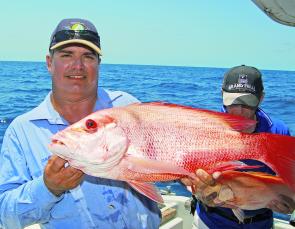
A nannygai taken drifting a deepwater rubble patch.
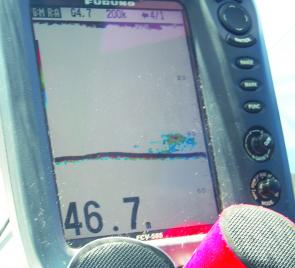
A sounder reading that gets everyone excited – A small shoal rise and fish stacked up!
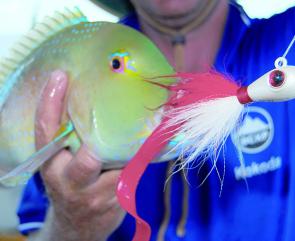
Jason Horton uses a jig to great effect on a coral reef drop-off.
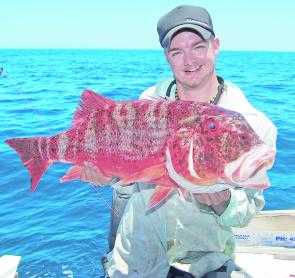
Over deepwater shoals even the vermin are massive!
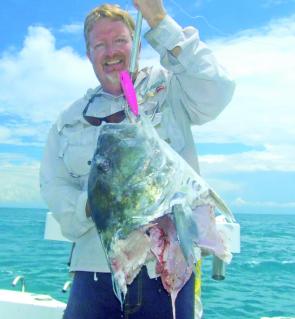
There's always something bigger and meaner out on the reef!




